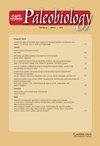亚得里亚海北部全新世底栖生物栖息地和营养状况对钻井捕食的尺度依赖性
IF 2.7
2区 地球科学
Q2 BIODIVERSITY CONSERVATION
引用次数: 1
摘要
摘要捕食强烈地塑造了过去和现代的海洋生态系统,但钻探捕食模式的规模依赖性是一个有争议的问题,钻探捕食是化石记录中最广泛使用的捕食者-猎物相互作用的代表。为了评估空间和分类尺度对钻探频率(DFs)的时间趋势的影响,我们在层序地层背景下分析了亚得里亚海北部陆架不同底栖生物栖息地和营养状况的全新世软体动物组合。尽管有假设认为,低捕食压力促进了亚得里亚海北部陆架东部相对少营养部分的高生物量层外群落的发展,但在研究组合中,DFs高达30%-40%,表明钻探捕食水平与典型的晚新生代生态系统相当。在局地尺度上,df有从海侵体系域(TST)向高水位体系域(HST)增加的趋势,反映了近1万年来水深增加了20 ~ 40 m,生境由沿海下缘向环流的转变。由于海侵沉积在较浅的位置较厚,而高位沉积在较深的位置较厚,因此只有当这些差异被考虑在内时,从TST到HST的df的区域增加才很明显。在总组合、总纲和少数富广布科水平上,可以看到向HST方向的DF增加,但在属和种水平上,由于其特定的环境要求,DF消失,导致空间和时间上的不均匀或斑状分布。本文章由计算机程序翻译,如有差异,请以英文原文为准。
Scale dependence of drilling predation in the Holocene of the northern Adriatic Sea across benthic habitats and nutrient regimes
Abstract. Predation has strongly shaped past and modern marine ecosystems, but the scale dependency of patterns in drilling predation, the most widely used proxy for predator–prey interactions in the fossil record, is a matter of debate. To assess the effects of spatial and taxonomic scale on temporal trends in the drilling frequencies (DFs), we analyzed Holocene molluscan assemblages of different benthic habitats and nutrient regimes from the northern Adriatic shelf in a sequence-stratigraphic context. Although it has been postulated that low predation pressures facilitated the development of high-biomass epifaunal communities in the eastern, relatively oligotrophic portion of the northern Adriatic shelf, DFs reaching up to 30%–40% in the studied assemblage show that drilling predation levels are comparable to those typical of late Cenozoic ecosystems. DFs tend to increase from the transgressive systems tract (TST) into the highstand systems tract (HST) at the local scale, reflecting an increase in water depth by 20–40 m and a shift from infralittoral to circalittoral habitats over the past 10,000 years. As transgressive deposits are thicker at shallower locations and highstand deposits are thicker at deeper locations, a regional increase in DFs from TST to HST is evident only when these differences are accounted for. The increase in DF toward the HST can be recognized at the level of total assemblages, classes, and few abundant and widespread families, but it disappears at the level of genera and species because of their specific environmental requirements, leading to uneven or patchy distribution in space and time.
求助全文
通过发布文献求助,成功后即可免费获取论文全文。
去求助
来源期刊

Paleobiology
地学-古生物学
CiteScore
5.30
自引率
3.70%
发文量
38
审稿时长
>12 weeks
期刊介绍:
Paleobiology publishes original contributions of any length (but normally 10-50 manuscript pages) dealing with any aspect of biological paleontology. Emphasis is placed on biological or paleobiological processes and patterns, including macroevolution, extinction, diversification, speciation, functional morphology, bio-geography, phylogeny, paleoecology, molecular paleontology, taphonomy, natural selection and patterns of variation, abundance, and distribution in space and time, among others. Taxonomic papers are welcome if they have significant and broad applications. Papers concerning research on recent organisms and systems are appropriate if they are of particular interest to paleontologists. Papers should typically interest readers from more than one specialty. Proposals for symposium volumes should be discussed in advance with the editors.
 求助内容:
求助内容: 应助结果提醒方式:
应助结果提醒方式:


